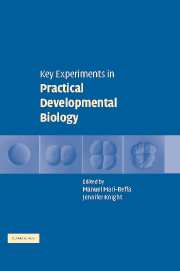Book contents
- Frontmatter
- Contents
- List of contributors
- Preface
- Introduction
- SECTION I GRAFTINGS
- SECTION II SPECIFIC CHEMICAL REAGENTS
- SECTION III BEAD IMPLANTATION
- SECTION IV NUCLEIC ACID INJECTIONS
- SECTION V GENETIC ANALYSIS
- 11 Segmental specification in Drosophila melanogaster
- 12 Genetic analysis of flower development in Arabidopsis thaliana. The ABC model of floral organ identity determination
- 13 Genetic analysis of vulva development in C. elegans
- SECTION VI CLONAL ANALYSIS
- SECTION VII IN SITU HYBRIDIZATION
- SECTION VIII TRANSGENIC ORGANISMS
- SECTION IX VERTEBRATE CLONING
- SECTION X CELL CULTURE
- SECTION XI EVO–DEVO STUDIES
- SECTION XII COMPUTATIONAL MODELLING
- Appendix 1 Abbreviations
- Appendix 2 Suppliers
- Index
- Plate Section
- References
13 - Genetic analysis of vulva development in C. elegans
Published online by Cambridge University Press: 11 August 2009
- Frontmatter
- Contents
- List of contributors
- Preface
- Introduction
- SECTION I GRAFTINGS
- SECTION II SPECIFIC CHEMICAL REAGENTS
- SECTION III BEAD IMPLANTATION
- SECTION IV NUCLEIC ACID INJECTIONS
- SECTION V GENETIC ANALYSIS
- 11 Segmental specification in Drosophila melanogaster
- 12 Genetic analysis of flower development in Arabidopsis thaliana. The ABC model of floral organ identity determination
- 13 Genetic analysis of vulva development in C. elegans
- SECTION VI CLONAL ANALYSIS
- SECTION VII IN SITU HYBRIDIZATION
- SECTION VIII TRANSGENIC ORGANISMS
- SECTION IX VERTEBRATE CLONING
- SECTION X CELL CULTURE
- SECTION XI EVO–DEVO STUDIES
- SECTION XII COMPUTATIONAL MODELLING
- Appendix 1 Abbreviations
- Appendix 2 Suppliers
- Index
- Plate Section
- References
Summary
OBJECTIVE OF THE EXPERIMENT In this chapter, I will introduce the experimental model organism Caenorhabditis elegans. Particular emphasis will be given to the advantages that this nematode offers for genetic studies. Several genes of ancient origin have been conserved during evolution in nematodes and vertebrates. They control essential aspects of cell viability, proliferation, signalling and differentiation in these organisms. Thus, characterisation of the function of a new gene (and consequently, of the biological pathway that it modulates) in C. elegans will allow better understanding of the corresponding pathway in vertebrates.
The characterisation of the genetic factors involved in inter- and intracellular signal transduction during vulva development in C. elegans will be presented as a paradigm to demonstrate the potential that this organism offers to the developmental biologist.
DEGREE OF DIFFICULTY Easy (Experiment 1a) to difficult (Experiments 1b and 2). Lab instructors and preferably students as well need to be experienced in basic molecular biology techniques and handling of C. elegans.
INTRODUCTION
C. elegans is a small worm (1 mm as adult), easy and cheap to grow under laboratory conditions. It has two sexes, hermaphrodite (two X chromosomes, XX) (Figure 13.1a) and male (one X chromosome, XO) (Figure 13.1b), allowing both self- and cross-fertilisations. It has a short reproductive cycle (three days at 20°C) and it can give rise to abundant progeny (up to 300 animals). In spite of its small size, it has a nervous system, muscles, and gut that are miniaturised and simplified versions of their vertebrate counterparts.
- Type
- Chapter
- Information
- Key Experiments in Practical Developmental Biology , pp. 153 - 166Publisher: Cambridge University PressPrint publication year: 2005



